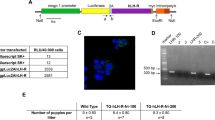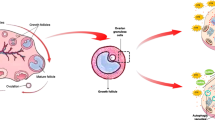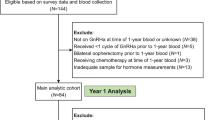Summary
The human breast cancer cell line (MCF7) was established as xenografts in intact female nude mice. Xenografts did not require oestrogen supplementation for growth, although oestrogen supplementation caused more rapid tumour growth. GnRH Pharmaccine is an immunogen composed of gonadotrophin releasing hormone (GnRH) linked to diphtheria toxoid. Anti-GnRH antibodies purified from the serum of rabbits immunized with GnRH Pharmaccine, were used to passively immunize nude mice. In mice treated with anti-GnRH antibodies, xenograft growth was significantly inhibited relative to controls (median times of 71 and 29 days respectively taken for tumours to attain a predetermined cross-sectional area of 200 mm2, P < 0.001). The inhibition of tumour growth achieved by anti-GnRH antibodies was not significantly different from that produced by the anti-oestrogen, tamoxifen (59 days). Ovarian/uterine weights were reduced by 61% (P < 0.001) in anti-GnRH antibody-treated animals compared with controls. Histologically there was underdevelopment and atrophy of the reproductive organs. Serum levels of both oestrogen and luteinizing hormone were reduced by treatment with anti-GnRH antibodies (to 24.9% and 53% respectively of levels in controls, both P = 0.04). It is postulated that one of the mechanisms by which anti-GnRH antibody treatment inhibits tumour growth is indirectly, by reducing serum oestrogen levels.
Similar content being viewed by others
Article PDF
Change history
16 November 2011
This paper was modified 12 months after initial publication to switch to Creative Commons licence terms, as noted at publication
References
Beatson, G. T. (1896). On the treatment of inoperable cases of carcinoma of the mamma: suggestions for a new method of treatment with illustrative cases. Lancet ii: 104–107.
Blamey, R. W., Jonat, W., Kaufmann, M., Raffaele Bianco, A. & Namer, M. (1992). Goserelin depot in the treatment of premenopausal advanced breast cancer. Eur J Cancer 28A: 810–814.
Cho, H., Aronica, S. M. & Katzenellenbogen, B. S. (1994). Regulation of progesterone receptor gene expression in MCF7 breast cancer cells: a comparison of the effects of cyclic adenosine 3′,5′-monophosphate, oestradiol, insulin-like growth factor-1 and serum factors. Endocrinology 134: 658–664.
Dowsett, M., Goss, P. E., Powles, T. J., Hutchinson, G., Brodie, A. M. H., Jeffcoate, S. L. & Coombes, R. C. (1987). Use of the aromatase inhibitor 4 hydroxyandrostenedione in postmenopausal breast care: optimisation of therapeutic dose and route. Cancer Res 47: 1957–1961.
Ferro, V. A. & Stimpson, W. H. (1997). Immunoneutralisation of gonadotrophin releasing hormone: a potential treatment for oestrogen-dependent breast cancer. Eur J Cancer 33: 1468–1478.
Gottardis, M. M., Robinson, S. P. & Jordan, V. C. (1988). Oestradiol-stimulated growth of MCF7 tumours implanted in athymic mice: a model to study the tumouristatic action of tamoxifen. J Steroid Biochem 30: 311–314.
Goulding, H., Pinder, S., Cannon, P., Pearson, D., Nicholson, R., Snead, D., Bell, J., Elston, C. W., Robertson, J. F., Blamey, R. W. & Ellis, I. O. (1995). A new immunohistochemical antibody for the assessment of oestrogen receptor status on routine formalin fixed tissue samples. Hum Pathol 26: 291–294.
Jacobs, E., Watson, S. A., Hardcastle, J. D. & Robertson, J. F. R. (1996). Oestrogen and progesterone receptors in gastrointestinal cancer cell lines. Eur J Cancer 32A: 2348–2353.
Kraus, W. L. & Katzenellenbogen, B. S. (1993). Regulation of progesterone receptor gene expression and growth in the rat uterus: modulation of oestrogen actions by progesterone and sex steroid hormone antagonists. Endocrinology 132: 2371–2379.
Lee, E. T. & Desu, M. M. (1972). A computer programme for comparing k samples with right censored data. Comp Progr Biomed 2: 315–321.
Lett, H. (1905). An analysis of ninety nine cases of inoperable carcinoma of the breast treated by oophorectomy. Lancet i: 227–228.
Osborne, K. C., Hobbs, K. & Clark, G. M. (1985). Effect of oestrogens and anti-oestrogens on growth of human breast cancer cells in athymic nude mice. Cancer Res 45: 584–590.
Williams, M. R., Walker, I. L. J., Turkes, A., Blamey, R. W. & Nicholson, R. I. (1986). The use of LH-RH agonist (ICI 118,630, Zoladex) in advanced premenopausal breast cancer. Br J Cancer 53: 629–636.
Williamson, K., Robertson, J. F. R., Ellis, I. O., Elston, C. W., Nicholson, R. I. & Blamey, R. W. (1988). Effect of LHRH agonist, Zoladex® on ovarian histology. Br J Surg 75: 595–596.
Yano, T., Korkut, E., Pinski, J., Szepeshazi, K., Milovanovic, S., Groot, K., Clarke, R., Comaru-Schally, A. M. & Schally, A. V. (1992). Inhibition of growth of MCF-7 MIII human breast carcinoma in nude mice by treatment with agonists or antagonists of LH-RH. Br Cancer Res Treat 21: 35–45.
Author information
Authors and Affiliations
Rights and permissions
From twelve months after its original publication, this work is licensed under the Creative Commons Attribution-NonCommercial-Share Alike 3.0 Unported License. To view a copy of this license, visit http://creativecommons.org/licenses/by-nc-sa/3.0/
About this article
Cite this article
Jacobs, E., Watson, S., Michaeli, D. et al. Anti-gonadotrophin releasing hormone antibodies inhibit the growth of MCF7 human breast cancer xenografts. Br J Cancer 80, 352–359 (1999). https://doi.org/10.1038/sj.bjc.6690362
Received:
Revised:
Accepted:
Published:
Issue date:
DOI: https://doi.org/10.1038/sj.bjc.6690362
Keywords
This article is cited by
-
Immunization with a recombinant GnRH vaccine fused to heat shock protein 65 inhibits mammary tumor growth in vivo
Cancer Immunology, Immunotherapy (2010)



